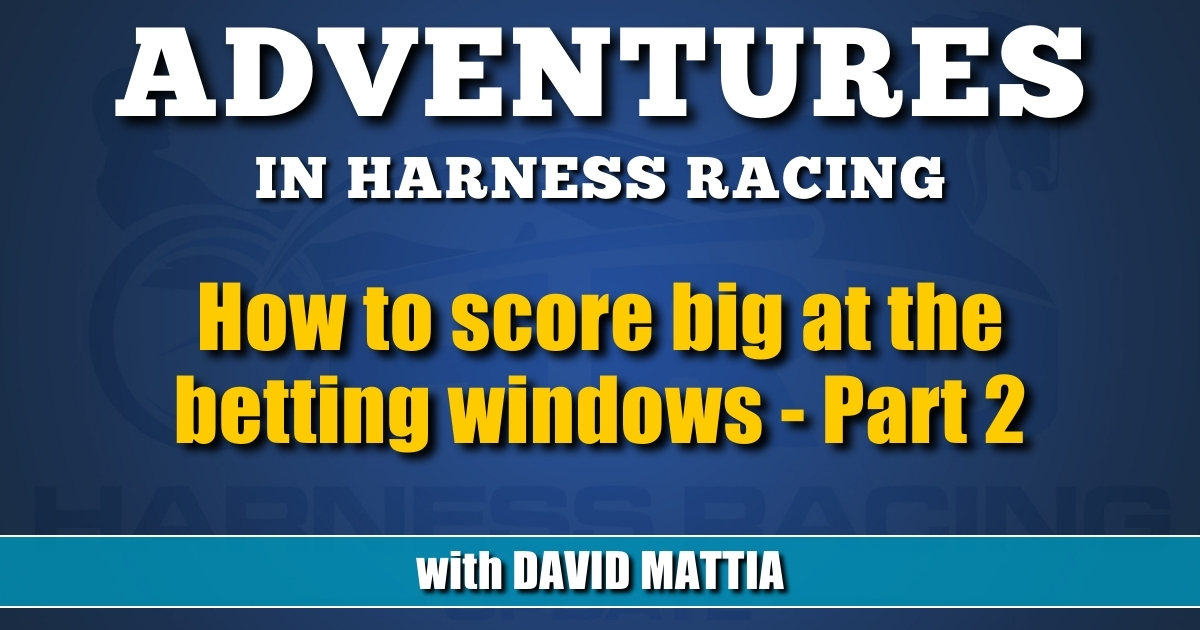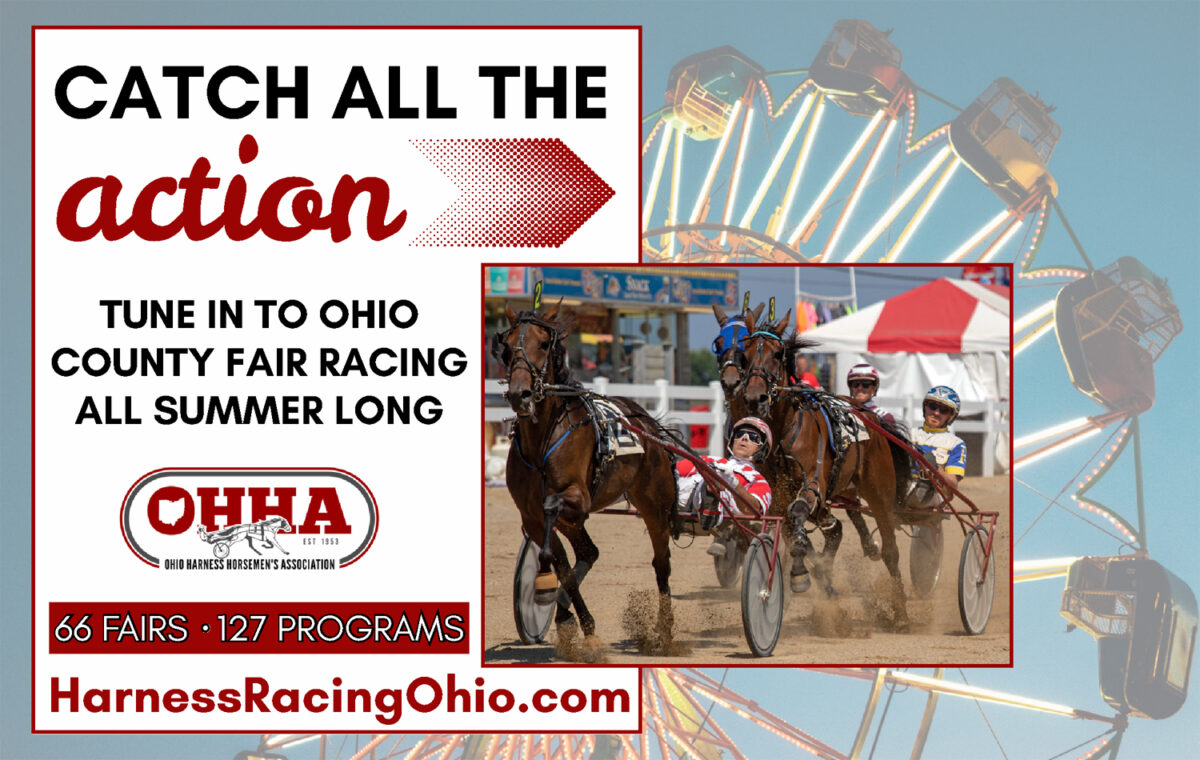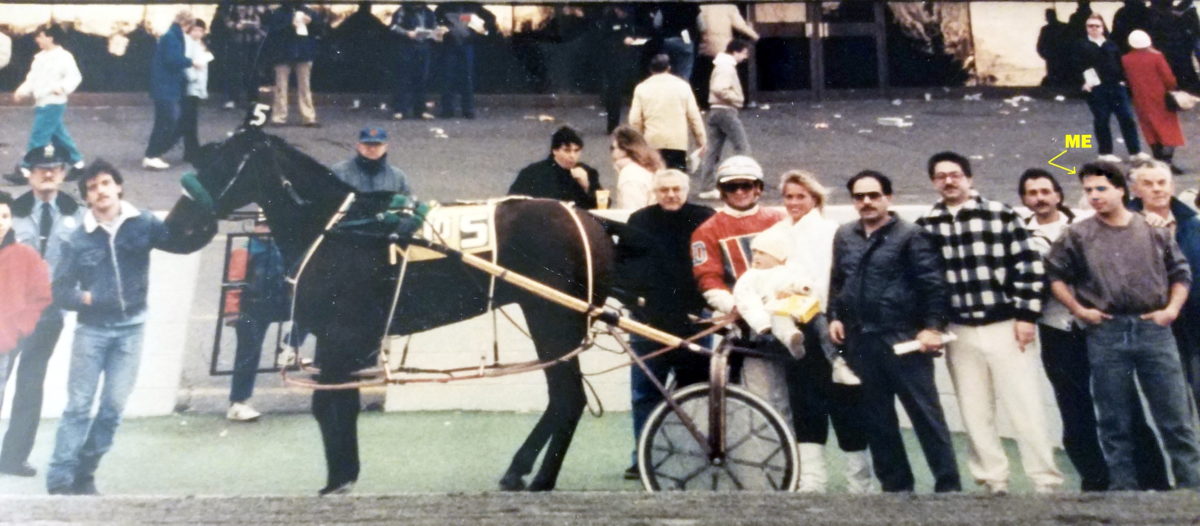How to score big at the betting windows – Part 2
All you need to know about handicapping harness horses and making money betting on them by recognizing when you have stumbled upon the equivalent of sperm whale poop.
by David Mattia
Maybe this sounds nonsensical, but one cannot have inside information about a horse unless one has actual inside information on a horse. Such was the case as per my tangential involvement in the private life of Kassa Branca – a monstrous son of No Nukes that I still remember with great affection. Maybe you remember him too.
Kassa Branca’s private life, apropos of my story, and not an isolated incident by any means, is literally the Rosetta Stone of why you can’t etch anything in stone when it comes to a horse’s past performances printed on the pages of a program or any mental notes made about its previous start or starts.
Okay, now we have arrived at those perfumery undertones; the rare ingredient you’ll need if you really want to score.
Did you know that the costliest perfumes in the world contain an ingredient called ambergris?
Ambergris is a waxy blob, disguised as a floating rock, that washes up on beaches throughout the world. It’s exceedingly rare, and illegal to possess in some countries. If you come upon a chunk, especially if it’s big, you’ve made yourself a small fortune because it’s a specific kind of sperm whale poop that is, pound for pound, far more valuable than gold. It’s the ingredient in high-end perfumes that makes a fine fragrance stick to your skin. It doesn’t evaporate and it holds down those elusive undertones.
If you find a big enough glob of ambergris, you can stop reading because you no longer need to wager on horses.
Stumbling upon genuine inside information about a horse, is like finding a glob of ambergris. This information, legally obtained by observation or happenstance, is the sperm whale poop of horse betting because it sticks. In the case of Kassa Branca, I’d discovered equine ambergris in the form of a priceless glob of inside information about the private life of the horse.
This is how I cashed in on my equine ambergris.
When I was first starting out, stabled one barn away from Kassa Branca, I made a fortune betting a few bucks against him when he jumped it off right out of the gate in a big race at Freehold at odds of about 1-9. The minus pool for show was huge and I walked away as a fearlessly young guy with thousands of dollars in my pocket simply because I knew something that no analyst or grandstand gambler could have ever known – the horse was cooked.
I don’t know exactly what was wrong with him at the time, and apparently neither did the cadre of veterinarians who came and went from his stall while wearing deeply concerned faces in the week preceding a big stakes race for which he was a gigantic favorite. Whatever was wrong remains a mystery to me, but I clearly remember how no one in that camp looked particularly happy.
Meanwhile, the handicappers, both professional and amateur, hammered Kassa Branca with oblivious praise and doomed bridge-jumper mutuel money. For me, however, it was priceless info about a horse who had absolutely nothing to do with me but who I knew for certain had no chance of winning. He did, however, go on to live a long, happy, and productive life. In fact, years later, I would go on to train one of his talented daughters. Her name was Kassa Girl, and I remember her fondly.
Remember earlier when I said that I never bet? Well, I kind of fibbed. To be perfectly clear, I will sometimes bet on horses, but I never gamble. I know that sounds like a clever use of a euphemism, but that’s not my intention. Let me explain what I mean.
Throughout my career I have, on exceedingly rare occasions, invested money into a race, but only because I knew something. I’d found a few morsels of ambergris – usually about my own horses.
I had valuable inside information because it involved my own horses. I knew something that can’t be assigned a sign or symbol on the program. Mind you, there was nothing shady or crooked about any of these scores. I won honest money by betting my own horse simply because of something that had changed since its last race. If someone had asked me about any of these horses, I would have told them the absolute truth, but they should have already suspected something had they bothered to look for equipment changes which are unimpeachable sources of authentic information. In fact, as this story moves along, I will tell you about each score and how it happened.
Kassa Branca, a world champion, is a perfect example of how betting AGAINST a horse can be lucrative despite what the program or the professional analysts tell you to the contrary. But Kassa Branca was someone else’s horse. Winning big on your own horse is a lot more fun because you get the betting money, the purse money and the glory.
Keep in mind that you should never look to make money by betting AGAINST your own horse. That’s shady and I am fairly sure it’s illegal. It’s also unethical and inhumane for a trainer to race a horse if he or she knows for certain that it’s sore or sick. Betting against your own horse because you know it’s physically impaired is criminally foolish. Thankfully, I can’t remember anyone I ever raced with who did that.
When I mentioned about the outside burr headpole before, I didn’t mean to suggest that a trainer is intentionally racing a sore horse and rigging around that soreness. It’s just that most horsemen go through the same motions as they slowly figure out why a horse is doing this or that in a race. Usually, they never figure it out, but on a few occasions, I did, and it paid off enormously.
Early on in my harness racing career, too early if you ask me, I was given a famous horse to rehabilitate. His name was Watchit Skipper. At least 50 per cent of my readers – especially some racing analysts — bugged out because Watchit Skipper was a punter’s superman. He always finished exactly where he figured to finish – usually first.
If you wagered or raced at Yonkers or Roosevelt or Freehold in the late 1980s, you knew Watchit Skipper. Devoid of any personality, he was instead a determined robot who could get around a half-mile turn like a Porsche Carrera.
Before he injured a ligament behind his right knee, Skip was one of the best open class pacers in the country. He was famous for his blue-collar grit. He loved being first over, and if he got the lead passing the three-quarter pole, he refused to be passed. Legend has it that Walter Case developed his patented three-wide at the half move while sitting behind Watchit Skipper. We’ll have to check with Walt about that.
Before I got him, “Skip” had been trained by a few of the top trainers, and he always wore an outside burr headpole or Murphy blind. Apart from his talent, Skip’s claim to fame at the time I got him was that his $125,000 tag, along with the New York State sales tax, made him the highest priced claim in the history of harness racing. He had to dip into the high-end claimers whenever the season’s stake horses dropped in for an Invitational event. His claiming price record has since been broken.
Odds were against him making it back to the races, but because the nature of his injury would never be life-threatening, and he always had a forever home waiting for him, I found it easy to give it a try.
After months of training and swimming, he was ready to go, but just before he qualified, I noticed that he was starting to grab that left line in the straights but coming off it in the turns. Now, what’s the first thing anyone would do if a horse gets back on the left line but vets out sound? They’d put that headpole and Murphy blind right back on, right? Not me.
I had a gut feeling that something had never been 100% right in his left hind, and whatever it was, it eventually led to his right front injury. I mean, this horse was so determined to keep his nose in front that he abused his right front to keep off his left hind. Usually, a horse will figure this out, but with the really game ones, they wait until they’ve made a million dollars before they start protecting themselves.
I know that sounds like CARE AND TRAINING OF THE TROTTER AND PACER – the 1940 edition – but in this case it was true. Contrary to the norm, my youth and curiosity worked in my favor. Instead of reaching for a headpole, I reached out for an old veterinarian. Well., I thought he was old, but he was probably about 35. His name is Dr. Rick Balmer. He held up the horse’s left hind and said, “Now, if I press here and he flinches, we found the problem.” Doc pressed and Skip flinched. Problem solved. Headpole and Murphy tossed aside. Ambergris uncovered.
Every young trainer should start out with a great horse and a great veterinarian. It’s like learning to speak English when you’re a child and your teachers speak like Shakespearean actors. You’re going to learn it and you’re going to learn it right. Do you know what I mean?
Anyway, it was just a jack cord. It was the most minor thing. In fact, it was something that a lot of old-time guys used to look for. How had it gone undetected for so long? If you don’t know what a jack cord is, you might be reading the wrong publication.
So, I qualified Skip and he was good. Because he was so well known, and I wasn’t, everyone expected a disaster, but that’s the opposite of what happened. He started winning again, and in time he had worked his way back to the upper classes. At 7 years old, however, he was starting to get old. After he won an open pace at Freehold (see the video here) I decided to put him for a $75,000 tag. He wasn’t great, and it was decided that $60,000 was a better spot. He won that easily, but he got claimed.
For his new connections he raced so-so for one start but when I checked the equipment board the next week, the new connections had added the dreaded outside headpole and Murphy blind. The jack cord thing must have been coming back and he raced poorly. The following week, they added a Murphy blind and an outside burr headpole, then a rolling burr, then a steering bar. He was running out so badly that throughout the course of several months, he earned nothing. The only thing he gained was more and more rigging. Had he looked lame I would have jumped in with heroics, but he was just locked on the line and pacing slowly because he’d finally figured out how to protect himself. Mind you, this horse was a total professional and I was the only person who knew what was wrong.
Just as I was about to intervene with my inside info – the key to the horse – I got a call from the new connections asking me if I wanted him back. They wanted $20,000 — as is. I asked to sit behind him, they agreed. The moment I grabbed the lines I knew all I needed to know, so I drove away with him for a haggled $18,000. I’m sure they thought I was an idiot. I guess I could have just told them how to fix him in an instant, but business is business. Those are easy words for most people to say, but I don’t like that I did this. It always bugged me that I took advantage of that situation. I suspect that it’s the least dignified thing I ever did in harness racing, unless you count the brocade jacket I wore to the Hambletonian in 2017. What was I thinking?
Anyway, I got Watchit Skipper back to my barn, called Dr. Balmer, got him off the line in three-seconds, waited two weeks and entered him in a race where he appeared to be buried – at least on poisonous paper. He was the longest shot on the board. Do you remember when I told you that horses have private lives, and that racing analysts and handicappers cannot factor this into their selections? Do you remember when I warned you about the poison on the paper?
If I had been interviewed prior to the race and asked the typical things about getting my classy old horse back, and how did I like him, what would I have said? Probably something like, “I’m excited to have him back. I made some changes and he trained well and with a little luck… blah, blah. blah.”
See what I mean? I wouldn’t be lying. I couldn’t very well say, “There is a key to this horse, and I am the only person who knows it and he is going to crush these horses because I fixed it.”
I mean, that’s what I was thinking, but If I’d said it, I would have sounded like a pushy neophyte. Naturally, I would have a thousand people singing my praises if he rolled over the field and won – which he did – but how long would my new fans have stuck around even though Watchit Skipper would yet again make a huge comeback? The guy who claimed him for $60,000 and sold him back to me for $18,000 with a hidden snicker got a dozen new horses from his owners. All I got was my horse back and about $10,000 from my win bet when he won easily at odds of 60-1. For me, that seemed more than fair.
Why did a former champion pay $60 to win after a 10-month layoff against horses he used to walk over? That’s easy to answer. Everyone focused on the long layoff and the young nobody trainer, but far more importantly, no one bothered to notice the revealing equipment change: “Minus rolling burr headpole right side, minus Murphy blind right side. Minus steering bar.”
Add to this mix, his general appearance in the post parade. Rather than pull and fret, something I had seen him do long before I had him, he simply loped along athletically, head down with that kind of blasé poise that a lot of great horses have.
Sure, I took advantage of what I knew, things that weren’t at all apparent in the program, but the equipment changes and the way he scored down shouted, “BET ME!” No one bothered to sniff out either the overtones or the undertones.
It’s also nice to see that Dr. Balmer, the only other person privy to the horse’s key, was simply content to help the horse. He didn’t involve himself in any other way. He’s just a brilliant veterinarian who cares about the welfare of the horses he treats.
Okay, so we got one betting story out of the way. In the next issue I will finish up with two more examples.


















